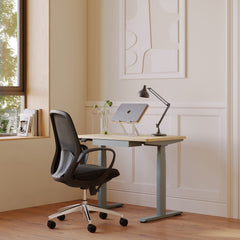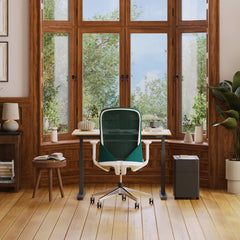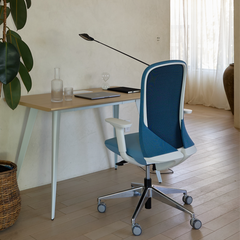Get 10% off your first order
Find the office furniture that’s designed to match your style, comfort, and needs perfectly. Subscribe
Space Shift: The Art of the Live-Work Fusion

Visit quiz page to see how we makes it easy to create an inspiring workplace


In a world filled with digital noise and constant demands, a dedicated reading nook is more than a comfortable corner—it is a personal sanctuary. This space is designed for one purpose: deep, uninterrupted rest and immersion. Creating this cozy retreat requires a careful blend of comfort, function, and aesthetics, with the right chair and intentional lighting acting as the foundation.
A truly successful reading nook minimizes sensory friction, allowing your mind to fully engage with the book in your hands. It is an act of self-care built from deliberate design choices. This space should feel entirely separate from your high-activity zones, like the kitchen or your main workspace, offering a clear psychological buffer for relaxation.
Humans have a natural inclination toward enclosed, protected spaces—a concept known as prospect and refuge. A reading nook should offer a clear "refuge" where you feel safe and shielded from the surrounding environment. This feeling of enclosure, combined with focused light, is the key to deep relaxation and mental decompression.
While this article focuses on relaxation, the need for a dedicated, separate space is a core theme in productivity. Even if your main office is compact, you need tools that aid focus. If you struggle to fit all your activities, consider how compact, specialized furniture can help. For instance, a Small Standing Desk North Dakota is designed to fit into narrow spaces, proving that every corner of your home can be maximized for a specific, beneficial function.
The chair is the absolute centerpiece of the reading nook. It must invite you to settle in for hours, supporting your body in a relaxed, yet attentive, posture. The goal is comfort without slouching, ensuring your back and neck are fully supported.
While aesthetic appeal is important, the chair must provide ergonomic support for extended sitting. Look for features that support the natural S-curve of the spine and offer a high back or headrest for neck relaxation.
Deep Seat: A seat deep enough to support your thighs fully, allowing your feet to rest flat on the floor or an ottoman.
High Backrest: Essential for resting your head and neck, preventing muscle fatigue while holding a book.
Armrests: Must be wide and padded enough to comfortably support your elbows while holding a book or e-reader.
Optimal Firmness: The cushion should be supportive, not too soft, which prevents you from sinking and shifting into poor posture.
Even if you prefer a traditional armchair, incorporating an elegant, supportive seat—like a sophisticated ergonomic chair designed for sustained, comfortable sitting—can elevate the nook's functionality while maintaining a stylish look.
Poor lighting is the fastest way to ruin a reading nook, causing immediate eye strain and headaches. The lighting must be highly focused and bright enough for detail work (like reading fine print) without causing glare.
Effective reading light is achieved by layering: ambient light for atmosphere, and targeted task light for the page.
Reading Light Setup (Enumeration):
Focused Task Lamp: Use a floor lamp or a wall-mounted sconce positioned behind or beside the chair. The light source should aim directly at the book, not into your eyes.
Adjustable Arm: The lamp needs a flexible or adjustable arm to position the light perfectly over the page, regardless of how you shift your posture.
Warm Ambient Light: Use a soft overhead light or string lights to provide a gentle background glow, enhancing the cozy atmosphere.
Bulb Temperature: Choose a daylight (white) bulb (around 4000K) for the task light to reduce eye strain, and a warm (yellow) bulb (around 2700K) for the background ambient light.
The location of your reading nook is critical for ensuring it feels like a true sanctuary. It should be deliberately positioned away from high-traffic, high-noise areas to minimize visual and auditory interruptions.
The ideal spot leverages the existing architecture to create a sense of enclosure.
Nook Placement Checklist:
☐ Corner Location: Corners naturally provide two walls of enclosure, enhancing the sense of refuge.
☐ Window Access: Position the chair near a window for natural light, but ensure the window is not the main view into a busy or distracting area.
☐ Noise Barrier: Place the nook on the opposite side of the room from main doorways, the TV, or the kitchen.
☐ Temperature Control: Ensure the spot is not directly under an air vent or near a cold draft, as physical discomfort breaks focus.
A well-designed nook keeps everything you need within arm's reach. You should never have to get up once you start reading. This requires an appropriately sized side table or a small, integrated surface.
The surface should be large enough only for essentials: a book, a drink, and perhaps reading glasses. Too large a surface invites clutter and breaks the sense of coziness.
Choose a thin, C-shaped side table that can slide right over the arm of the chair for maximum proximity.
Incorporate a piece that offers a small surface and closed storage for extra blankets or journals.
This deliberate approach to nearby surfaces contrasts sharply with a formal modern office desk, which is designed to hold multiple devices and files. The nook desk is about reduction, not expansion.
Cozy design relies heavily on tactile sensations. Introducing soft textures and layers of materials encourages relaxation and physical comfort, making the space feel instantly inviting.
Layering different materials creates visual and physical depth. This helps the nook feel intentionally separate and rich in texture.
Texture Layering Strategies (Table):
|
Layer |
Material Type |
Purpose |
Mood Impact |
|
Foundation |
Area Rug (Wool or Jute) |
Defines the space; adds warmth underfoot. |
Grounded, soft. |
|
Body |
Chair Upholstery (Velvet or Linen) |
Provides primary seated comfort and texture. |
Luxurious, inviting. |
|
Accent |
Throw Blanket (Knit or Faux Fur) |
Provides warmth; introduces contrasting texture. |
Cozy, sheltered. |
|
Support |
Lumbar Pillow (Patterned Fabric) |
Provides minor ergonomic support; adds color. |
Relaxed, artistic. |

The colors in your reading nook should actively promote calm and focus. Bold, high-energy colors like red or bright yellow should be avoided in favor of soothing, deep tones.
Cool and deep colors are psychologically linked to rest and reflection.
Deep Blues and Greens: Associated with nature, clarity, and calmness; excellent for promoting mental decompression.
Warm Neutrals: Colors like cream, taupe, and terracotta provide warmth without visual noise.
Dark Accents: Using a dark color on one wall or in large furnishings can create a cocoon-like effect, enhancing the sense of refuge.
To truly immerse yourself in a book, you must create a zero-distraction environment. This involves physically and digitally isolating the nook from the demands of work and technology.
The nook should be a device-free zone (excluding e-readers). It serves as a designated space for disengagement, which is crucial for mental well-being.
The importance of this psychological break is strongly supported by external research. The need for clear boundaries between work and personal life is key. Studies on well-being and engagement, as highlighted in work psychology journals, confirm that controlling one's non-work environment is vital for reducing stress and preventing burnout. The reading nook is your physical tool for achieving this control.
A pile of unread books or random magazines around the nook instantly creates visual clutter, undermining the peaceful atmosphere. Effective, built-in storage is essential for maintaining order.
Storage should be aesthetically pleasing and easily accessible, yet not the focus of the space.
Storage Solutions (Bullet Points):
Built-in shelving or wall-mounted floating shelves near the chair.
Ottomans with hidden storage for blankets and books.
Slim, floor-to-ceiling bookcases that minimize the footprint while maximizing capacity.
Using only one or two decorative bookends to keep the current reading pile tidy.
The final touches transform a comfortable corner into your sanctuary. These sensory details enhance the overall immersive experience of the nook.
Scent: Use a candle or diffuser with a calming scent like sandalwood, vanilla, or cedarwood.
Sound: Place a small potted plant near the window to introduce the quiet visual of nature.
Visual Interest: A piece of calming artwork or a framed photograph that evokes peace and stillness.
The key to deep relaxation is ensuring that no part of your high-stress work environment can encroach on the nook. This requires managing all devices and monitors used for work.
Even if your reading nook is right next to your workspace, the work tools must be put away. If you rely on an external monitor for your job, consider the flexibility of its support system. A precision monitor mount allows you to push your work screen entirely out of sight and away from the reading area once the workday is complete, physically and visually restoring the home environment.

Creating a cozy reading nook is the art of intentional limitation: limiting noise, limiting distractions, and limiting uncomfortable posture. By choosing the right supportive chair, focusing your lighting, and rigorously protecting the space from technological intrusion, you design a psychological switch. This sanctuary is where you trade the demands of the day for the profound rest of deep immersion, proving that the most valuable design element is the peace you create. Settle in, turn the page, and let the world wait.

Space Shift: The Art of the Live-Work Fusion

How to Arrange Furniture to Maximize Peace

Designing a Low-Waste Home Interior with High-Quality Furniture
Get 10% off your first order
Find the office furniture that’s designed to match your style, comfort, and needs perfectly. Subscribe
Leave a comment